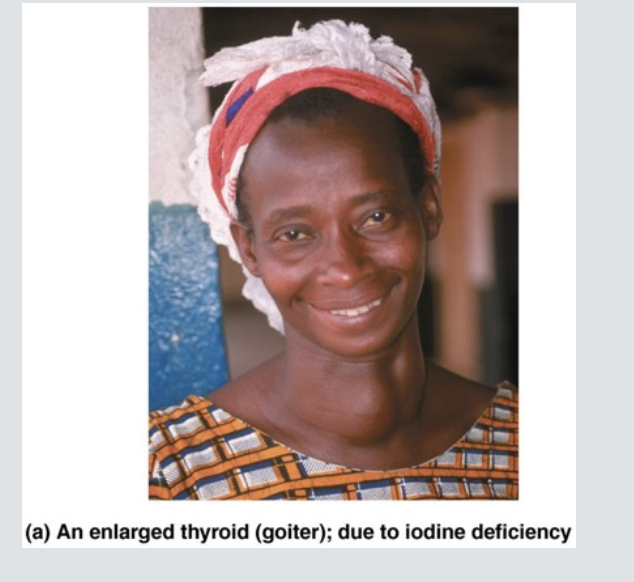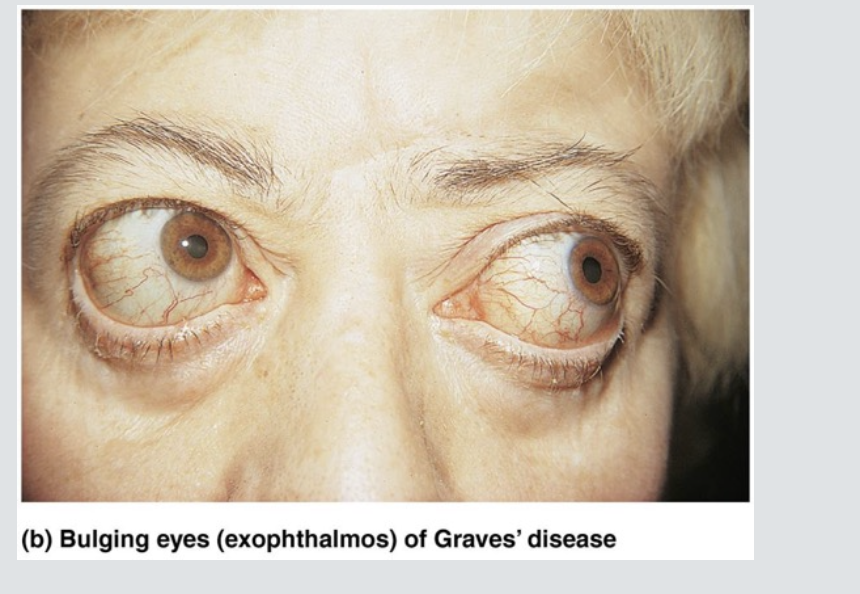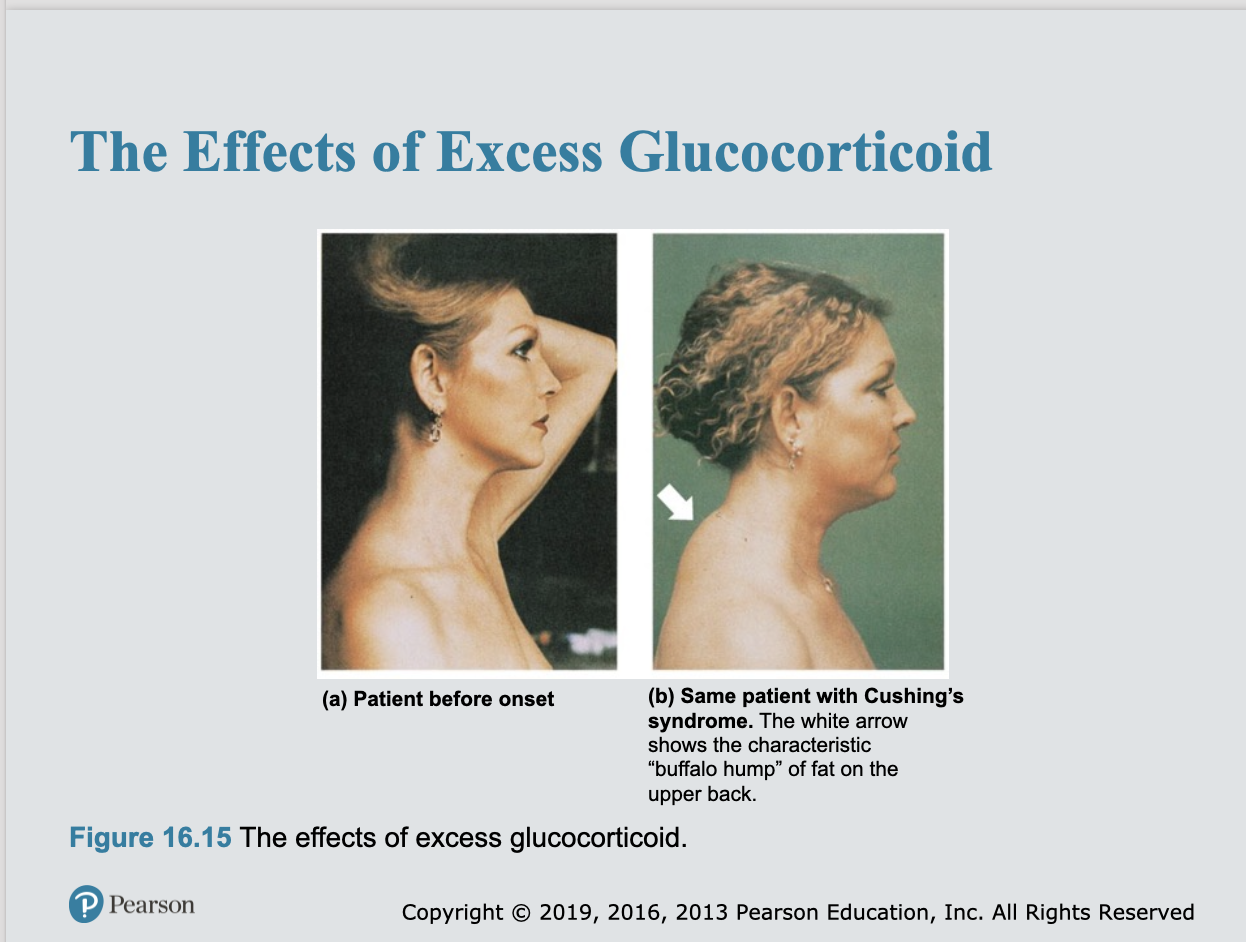Homeostasis Endocrine System
1/19
There's no tags or description
Looks like no tags are added yet.
Name | Mastery | Learn | Test | Matching | Spaced |
|---|
No study sessions yet.
20 Terms
Diabetes insipidus
ADH deficiency due to damage to hypothalamus or posterior pituitary
Must keep well hydrated
Syndrome of inappropriate ADH secretion (SIADH) -
Retention of fluid, headache, disorientation
Fluid restriction; blood sodium level monitoring
Hypersecretion of GH is usually caused by anterior pituitary tumor
In children results in gigantism
Can reach heights of 8 feet
In adults results in acromegaly
Overgrowth of hands, feet, and face
Hyposecretion of GH
In children results in pituitary dwarfism
May reach height of only 4 feet
In adults usually causes no problems
Hypersecretion of prolactin is more common than hyposecretion
Hyposecretion not a problem in anyone except women who choose to nurse
Hyperprolactinemia is the most frequent abnormality of anterior pituitary tumors
Clinical signs include inappropriate lactation, lack of menses, infertility in females, and impotence in males
Hyposecretion of TH in adults can lead to
myxedema
Symptoms include low metabolic rate, thick and/or dry skin, puffy eyes, feeling chilled, constipation, edema, mental sluggishness, lethargy
If due to lack of iodine, a goiter may develop
Lack of iodine decreases TH levels, which triggers increased TSH secretion, triggering thyroid to synthesize more and more unusable thyroglobulin
Thyroid enlarges

TH is critical for normal growth and brain development in early childhood
congenital hypothyroidism
usually caused by poor development of thyroid gland.
Pituitary problems or maternal medications may sometimes rarely affect baby’s ability to make TH
May be asymptomatic or present with weak cry, poor feeding, constipation or prolonged jaundice
TH replacement is crucial and is usually lifelong
Graves’ disease -
Autoimmune disease: body makes abnormal antibodies directed against thyroid follicular cells
Antibodies mimic TSH, stimulating TH release
Symptoms include elevated metabolic rate, sweating, rapid and irregular heartbeats, nervousness, and weight loss despite adequate food
Exophthalmos may result: eyes protrude as tissue behind eyes becomes edematous and fibrous
Treatments include surgical removal of thyroid or radioactive iodine to destroy active thyroid cells

Hyperparathyroidism due to parathyroid gland tumor -
Calcium leaches from bones, causing them to soften and deform
Elevated Ca2+ depresses nervous system and contributes to formation of kidney stones
Osteitis fibrosa cystica: severe form resulting in easily fractured bones
Hypoparathyroidism -
following gland trauma or removal can cause hypocalcemia
Results in tetany, respiratory paralysis, and death
Aldosteronism;
hypersecretion usually due to adrenal tumors
Results in two major problems:
Hypertension and edema due to excessive Na+
Excretion of K+, leading to abnormal nonresponsive neurons and muscle
Hypersecretion—Cushing’s syndrome/disease
Depresses cartilage/bone formation and immune system; inhibits inflammation; disrupts neural, cardiovascular, and gastrointestinal function
Causes: tumor on pituitary, lungs, pancreas, kidney, or adrenal cortex; overuse of corticosteroids
Cushingoid signs: “moon” face and “buffalo hump”
Treatment: removal of tumor, discontinuation of drugs
Hyposecretion—Addison’s disease -
Usually involves deficits in both glucocorticoids and mineralocorticoids
Decrease in plasma glucose and Na+ levels
Weight loss, severe dehydration, and hypotension are common
Treatment: corticosteroid replacement therapy
Early sign is characteristic bronzing of skin due to high levels of ACTH which triggers melanin production in melanocytes

Hypersecretion (adrenogenital syndrome (masculinization) -
Not noticeable in adult males
Already masculinized with testosterone, so no effect
Females and prepubertal males
Boys: reproductive organs mature; secondary sex characteristics emerge early
Females: beard, masculine pattern of body hair; clitoris resembles small penis
Hyposecretion -
Epinephrine and norepinephrine are not essential to life; therefore there are no problems associated with hyposecretion
Hypersecretion -
Leads to symptoms of uncontrolled sympathetic nervous system, such as:
Hyperglycemia, increased metabolic rate, rapid heartbeat, palpitations, hypertension, intense nervousness, and sweating
Can be due to pheochromocytoma, tumor of medullary chromaffin cells
Diabetes mellitus (DM) can be due to:
Hyposecretion of insulin: Type 1
Hypoactivity of insulin: Type 2
Three cardinal signs of DM:
Polyuria: huge urine output
Glucose acts as osmotic diuretic
Polydipsia: excessive thirst
From water loss due to polyuria
Polyphagia: excessive hunger and food consumption
Cells cannot take up glucose and are “starving”
When sugars cannot be used as fuel, as in DM, fats are used, causing
lipidemia: high levels of fatty acids in blood
Fatty acid metabolism results in formation of ketones (ketone bodies)
Ketones are acidic, and their build-up in blood can cause ketoacidosis
Also causes ketonuria: ketone bodies in urine
Untreated ketoacidosis causes hyperpnea, disrupted heart activity and O2 transport, and severe depression of nervous system that can possibly lead to coma and death
Hyperinsulinism -
Excessive insulin secretion
Causes hypoglycemia: low blood glucose levels
Symptoms: anxiety, nervousness, disorientation, unconsciousness, even death
Treatment: sugar ingestion
Effects of Environmental Pollutants
Exposure to pesticides, industrial chemicals, arsenic, dioxin, and soil and water pollutants disrupts hormone function
Sex hormones, thyroid hormone, glucocorticoids are all vulnerable to effects of pollutants
Interference with glucocorticoids may help explain high cancer rates in certain areas